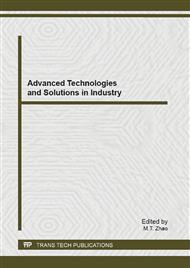p.152
p.157
p.161
p.166
p.170
p.174
p.178
p.182
p.186
Synthesis of CaWO4:(Eu3+,Tb3+) Thin Films by a Two-Step Method at Room Temperature
Abstract:
It is hardly possible to obtain rare earth doped CaWO4 thin films directly through electrochemical techniques. A two-step method has been proposed to synthesize CaWO4:(Eu3+,Tb3+) thin films at room temperature. X-ray diffraction, energy dispersive X-ray analysis, spectrophotometer were used to characterize their phase, composition and luminescent properties. Results reveal that (Eu3+,Tb3+)-doped CaWO4 films have a tetragonal phase. When the ratio of n (Eu)/n (Tb) in the solution is up to 3:1, CaWO4:(Eu3+,Tb3+) thin film will be enriched with Tb element; on the contrary, when the ratio in the solution is lower than 1:4, CaWO4:(Eu3+,Tb3+) thin film will be enriched with Eu element. Under the excitation of 242 nm, sharp emission peaks at 612, 543, 489 and 589 nm have been observed for CaWO4:(Eu3+,Tb3+) thin films.
Info:
Periodical:
Pages:
170-173
Citation:
Online since:
June 2013
Authors:
Keywords:
Price:
Сopyright:
© 2013 Trans Tech Publications Ltd. All Rights Reserved
Share:
Citation:


